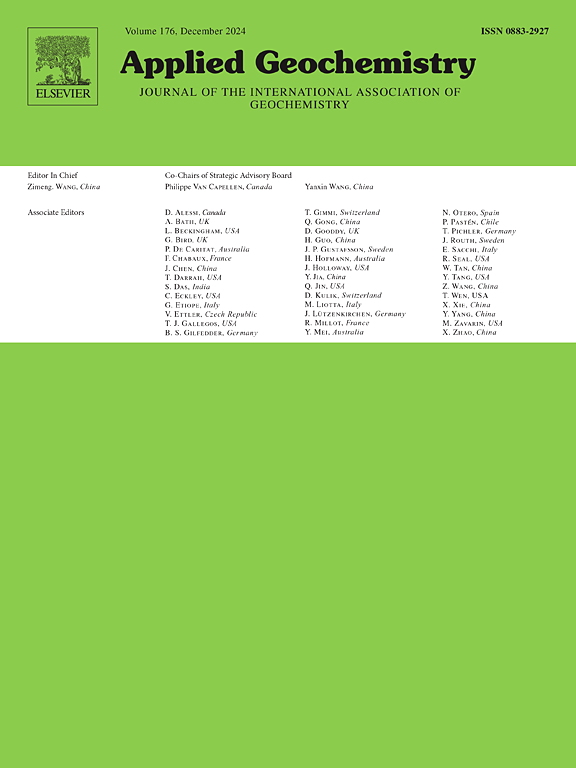Staffelegg组岩心分析富粘土沉积物的岩石地球化学和矿物学特征
IF 3.4
3区 地球科学
Q1 GEOCHEMISTRY & GEOPHYSICS
引用次数: 0
摘要
作为核废料深层地质处置宿主岩的泥质地层的长期完整性在很大程度上取决于水文地质因素。在Mont Terri岩石实验室(瑞士),从Opalinus粘土层钻了一个58米长的钻孔,穿过整个Staffelegg地层,其中包括两个含水部分。地下水分别在Beggingen和Rietheim成员(也称为Gryphaea石灰岩和Posidonia页岩)中被发现。我们希望通过表征矿物学和地球化学蚀变来确定地下水在富含粘土和碳酸盐的沉积物中流动的影响。地下水的影响仅限于含水带,可以通过裂缝和方解石脉来识别。矿物组合、岩石地球化学和不同氧化还原指标的组合等其他指标表明,在富粘土地区,地下水的影响有限。特别是在较小尺度(mm-μm)上研究含水层将有助于发现进一步的蚀变和动员特征。本文章由计算机程序翻译,如有差异,请以英文原文为准。
Bulk rock geochemical and mineralogical characterisation of clay-rich sediments from drill core analysis of the Staffelegg Formation
The long-term integrity of argillaceous formations as host rocks for deep geological disposal of nuclear waste depends significantly on hydrogeological factors. A 58 m long borehole was drilled at the Mont Terri Rock Laboratory (Switzerland) from the Opalinus Clay through the entire underlying Staffelegg Formation, which includes two water-bearing sections. Groundwater was found locally in the Beggingen and Rietheim Members, otherwise known as Gryphaea Limestone and Posidonia Shale, respectively. We want to identify indicators to determine the impact of groundwater flow in clay- and carbonate-rich sediments by characterising mineralogical and geochemical alteration. The groundwater influence is restricted to the water-bearing zones and can be identified by fractures and calcite veins. Additional indicators like mineral assemblage, rock geochemistry and the combination of different redox proxies, show constrained groundwater influence in the clay-rich areas. To investigate in particular the water-bearing horizons on a smaller scale (mm-m) would help to detect further alteration and mobilisation features.
求助全文
通过发布文献求助,成功后即可免费获取论文全文。
去求助
来源期刊

Applied Geochemistry
地学-地球化学与地球物理
CiteScore
6.10
自引率
8.80%
发文量
272
审稿时长
65 days
期刊介绍:
Applied Geochemistry is an international journal devoted to publication of original research papers, rapid research communications and selected review papers in geochemistry and urban geochemistry which have some practical application to an aspect of human endeavour, such as the preservation of the environment, health, waste disposal and the search for resources. Papers on applications of inorganic, organic and isotope geochemistry and geochemical processes are therefore welcome provided they meet the main criterion. Spatial and temporal monitoring case studies are only of interest to our international readership if they present new ideas of broad application.
Topics covered include: (1) Environmental geochemistry (including natural and anthropogenic aspects, and protection and remediation strategies); (2) Hydrogeochemistry (surface and groundwater); (3) Medical (urban) geochemistry; (4) The search for energy resources (in particular unconventional oil and gas or emerging metal resources); (5) Energy exploitation (in particular geothermal energy and CCS); (6) Upgrading of energy and mineral resources where there is a direct geochemical application; and (7) Waste disposal, including nuclear waste disposal.
 求助内容:
求助内容: 应助结果提醒方式:
应助结果提醒方式:


